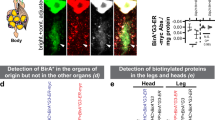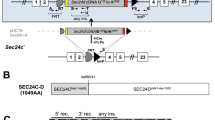Abstract
We describe the successful application of a modified gene-trap approach, the secretory trap, to systematically analyze the functions in vivo of large numbers of genes encoding secreted and membrane proteins. Secretory-trap insertions in embryonic stem cells can be transmitted to the germ line of mice with high efficiency and effectively mutate the target gene. Of 60 insertions analyzed in mice, one-third cause recessive lethal phenotypes affecting various stages of embryonic and postnatal development. Thus, secretory-trap mutagenesis can be used for a genome-wide functional analysis of cell signaling pathways that are critical for normal mammalian development and physiology.
This is a preview of subscription content, access via your institution
Access options
Subscribe to this journal
Receive 12 print issues and online access
$209.00 per year
only $17.42 per issue
Buy this article
- Purchase on Springer Link
- Instant access to full article PDF
Prices may be subject to local taxes which are calculated during checkout



Similar content being viewed by others
References
Gossler, A., Joyner, A.L., Rossant, J. & Skarnes, W.C. Mouse embryonic stem cells and reporter constructs to detect developmentally regulated genes. Science 244, 463–465 (1989).
Friedrich, G. & Soriano, P. Promoter traps in embryonic stem cells: a genetic screen to identify and mutate developmental genes in mice. Genes Dev. 5, 1515–1523 (1991).
Skarnes, W.C., Auerbach, B.A. & Joyner, A.L. A gene trap approach in mouse embryonic stem cells: the lacZ reporter is activated by splicing, reflects endogenous gene expression, and is mutagenic in mice. Genes Dev. 6, 903–918 (1992).
von Melchner, H. et al. Selective disruption of genes expressed in totipotent embryonal stem cells. Genes Dev. 6, 919–927 (1992).
Townley, D.J., Avery, B.J., Rosen, B. & Skarnes, W.C. Rapid sequence analysis of gene trap integrations to generate a resource of insertional mutations in mice. Genome Res. 7, 293–298 (1997).
Hicks, G.G. et al. Functional genomics in mice by tagged sequence mutagenesis. Nature Genet. 16, 338–344 (1997).
Zambrowicz, B.P. et al. Disruption and sequence identification of 2,000 genes in mouse embryonic stem cells. Nature 392, 608–611 (1998).
Wiles, M.V. et al. Establishment of a gene-trap sequence tag library to generate mutant mice from embryonic stem cells. Nature Genet. 24, 13–14 (2000).
Nolan, P.M. et al. A systematic, genome-wide, phenotype-driven mutagenesis programme for gene function studies in the mouse. Nature Genet. 25, 440–443 (2000).
Hrabe de Angelis, M. et al. Genome-wide, large-scale production of mutant mice by ENU mutagenesis. Nature Genet. 25, 444–447 (2000).
Wurst, W. et al. A large-scale gene-trap screen for insertional mutations in developmentally regulated genes in mice. Genetics 139, 889–899 (1995).
Forrester, L.M. et al. An induction gene trap screen in embryonic stem cells: identification of genes that respond to retinoic acid in vitro. Proc. Natl Acad. Sci. USA 93, 1677–1682 (1996).
Skarnes, W.C., Moss, J.E., Hurtley, S.M. & Beddington, R.S. Capturing genes encoding membrane and secreted proteins important for mouse development. Proc. Natl Acad. Sci. USA 92, 6592–6596 (1995).
Tate, P., Lee, M., Tweedie, S., Skarnes, W.C. & Bickmore, W.A. Capturing novel mouse genes encoding chromosomal and other nuclear proteins. J. Cell Sci. 111, 2575–2585 (1998).
Gasca, S., Hill, D.P., Klingensmith, J. & Rossant, J. Characterization of a gene trap insertion into a novel gene, cordon-bleu, expressed in axial structures of the gastrulating mouse embryo. Dev. Genet. 17, 141–154 (1995).
Voss, A.K., Thomas, T. & Gruss, P. Compensation for a gene trap mutation in the murine microtubule-associated protein 4 locus by alternative polyadenylation and alternative splicing. Dev. Dyn. 212, 258–266 (1998).
McClive, P. et al. Gene trap integrations expressed in the developing heart: insertion site affects splicing of the PT1-ATG vector. Dev. Dyn. 212, 267–276 (1998).
Sam, M. et al. Aquarius, a novel gene isolated by gene trapping with an RNA-dependent RNA polymerase motif. Dev. Dyn. 212, 304–317 (1998).
DeGregori, J.D. et al. A murine homolog of the yeast RNA1 gene is required for postimplantation development. Genes Dev. 8, 265–276 (1994).
Chen, Z., Friedrich, G.A. & Soriano, P. Transcriptional enhancer factor 1 disruption by a retroviral gene trap leads to heart defects and embryonic lethality in mice. Genes Dev. 8, 2293–2301 (1994).
Friedrich, G.A., Hildebrand, J.D. & Soriano, P. The secretory protein Sec8 is required for paraxial mesoderm formation in the mouse. Dev. Biol. 192, 364–374 (1997).
International Human Genome Sequencing Consortium. Initial sequencing and analysis of the human genome. Nature 409, 860–921 (2001).
Leighton, P.A. et al. Defining brain wiring patterns and mechanisms through gene trapping in mice. Nature 410, 174–179 (2001).
Skarnes, W.C. Gene trapping methods for the identification and functional analysis of cell surface proteins. Methods Enzymol. 328, 592–615 (2000).
Paine-Saunders, S., Viviano, B.L., Zupicich, J., Skarnes, W.C. & Saunders, S. Glypican-3 controls cellular responses to BMP4 in limb patterning and skeletal development. Dev. Biol. 225, 179–187 (2000).
Burgess, R.W., Skarnes, W.C. & Sanes, J.R. Agrin isoforms with distinct amino termini: differential expression, localization, and function. J. Cell Biol. 151, 41–52 (2000).
Chen, H. et al. Neuropilin-2 regulates the development of selective cranial and sensory nerves and hippocampal mossy fiber projections. Neuron 25, 43–56 (2000).
Pinson, K.I., Brennan, J., Monkley, S., Avery, B.J. & Skarnes, W.C. An LDL receptor-related protein mediates Wnt signaling in mice. Nature 407, 535–538 (2000).
Yeo, T.T. et al. Deficient LAR expression decreases basal forebrain cholinergic neuronal size and hippocampal cholinergic innervation. J. Neurosci. Res. 47, 348–360 (1997).
Cormick, C. et al. The putative tumour suppressor EXT1 alters the expression of cell-surface heparan sulfate. Nature Genet. 19, 158–161 (1998).
Lin, X. et al. Disruption of gastrulation and heparan biosynthesis in EXT1-deficient mice. Dev. Biol. 224, 299–311 (2000).
Brown, M.S. & Goldstein, J.L. A proteolytic pathway that controls the cholesterol content of membranes, cells, and blood. Proc. Natl. Acad. Sci. USA 96, 11041–11048 (1999).
Kawaguchi, T. et al. Purification and cloning of hepatocyte growth factor activator inhibitor type 2, a Kunitz-type serine protease inhibitor. J. Biol. Chem. 272, 27558–27564 (1997).
George, E.L., Georges-Labouesse, E.N., Patel-King, R.S., Rayburn, H. & Hynes, R.O. Defects in mesoderm, neural tube and vascular development in mouse embyros lacking fibronectin. Development 119, 1079–1091 (1993).
Jones, S.N., Roe, A.E., Donehower, L.A. & Bradley, A. Rescue of embryonic lethality in Mdm2-deficient mice by absence of p53. Nature 378, 206–208 (1995).
Ahn, J. et al. Cloning of a putative tumour suppressor gene for hereditary multiple exostoses (EXT1). Nature Genet. 11, 137–143 (1995).
Brown, S.D. et al. Isolation and characterization of LRP6, a novel member of the low density lipoprotein receptor gene family. Biochem. Biophys. Res. Comm. 248, 879–888 (1998).
Cano-Gauci, D.F. et al. Glypican-3-deficient mice exhibit developmental overgrowth and some of the abnormalities typical of Simpson–Golabi–Behmel syndrome. J. Cell Biol. 146, 255–264 (1999).
Serafini, T. et al. Netrin-1 is required for commissural axon guidance in the developing vertebrate nervous system. Cell 87, 1001–1014 (1996).
Cal, S., Freije, J.M., Lopez, J.M., Takada, Y. & Lopez-Otin, C. ADAM23/MDC3, a human disintegrin that promotes cell adhesion via interaction with the alphavbeta3 integrin through an RGD-independent mechanism. Mol. Biol. Cell 4, 1457–1469 (2000).
Shimano, H. et al. Elevated levels of SREBP-2 and cholesterol synthesis in livers of mice homozygous for a targeted disruption of the SREBP-1 gene. J. Clin. Invest. 100, 2115–2124 (1997).
Schmidt, C. et al. Scatter factor/hepatocyte growth factor is essential for liver development. Nature 373, 699–702 (1995).
Uehara, Y. et al. Placental defect and embryonic lethality in mice lacking hepatocyte growth factor/scatter factor. Nature 373, 702–705 (1995).
Bladt, F., Riethmacher, D., Isenmann, S., Aguzzi, A. & Birchmeier, C. Essential role for the c-met receptor in the migration of myogenic precursor cells into the limb bud. Nature 376, 768–771 (1995).
The, I., Bellaiche, Y. & Perrimon, N. Hedgehog movement is regulated through tout velu-dependent synthesis of a heparan sulfate proteoglycan. Mol. Cell 4, 633–639 (1999).
Bellaiche, Y., The, I. & Perrimon, N. Tout-velu is a Drosophila homologue of the putative tumour suppressor EXT-1 and is needed for Hh diffusion. Nature 394, 85–88 (1998).
Chiang, C. et al. Cyclopia and defective axial patterning in mice lacking Sonic hedgehog gene function. Nature 383, 407–413 (1996).
Sagane, K., Yamazaki, K., Mizui, Y. & Tanaka, I. Cloning and chromosomal mapping of mouse ADAM11, ADAM22 and ADAM23. Gene 236, 79–86 (1999).
Hodivala-Dilke, K.M. et al. Beta3-integrin-deficient mice are a model for Glanzmann thrombasthenia showing placental defects and reduced survival. J. Clin. Invest. 103, 229–238 (1999).
Kaartinen, V. et al. Abnormal lung development and cleft palate in mice lacking TGF-beta 3 indicates defects of epithelial-mesenchymal interaction. Nature Genet. 11, 415–421 (1995).
Watanabe, H. et al. Mouse cartilage matrix deficiency (cmd) caused by a 7 bp deletion in the aggrecan gene. Nature Genet. 7, 154–157 (1994).
Weinstein, M., Xu, X., Ohyama, K. & Deng, C.X. FGFR-3 and FGFR-4 function cooperatively to direct alveogenesis in the murine lung. Development 125, 3615–3623 (1998).
Brennan, J. & Skarnes, W.C. Gene trapping in mouse embryonic stem cells. Methods Mol. Biol. 97,123–138 (1999).
Wilkinson, D.G. & Nieto, M.A. Detection of messenger RNA by in situ hybridization to tissue sections and whole mounts. Methods Enzymol. 225, 361–367 (1993).
Parr, B.A. & McMahon, A.P. Dorsalizing signal Wnt-7a is required for normal polarity of D-V and A-P axes of mouse limb. Nature 374, 350–353 (1995).
Acknowledgements
We thank A. Smith for providing us with the feeder-independent ES cell lines and the Oct4 probe, C. Wright for the Mox1 probe, J. Gladden for his help on the PST9 phenotype analysis, Sheila Avery for help with formatting Fig. 1, and A. Jeske and S. Elson for technical support. Funding for this project was provided by grants to W.C.S. and M.T-L. by a Program in Genomics Applications from the National Heart, Lung, and Blood Institute (NHLBI), grants to W.C.S. from the BBSRC (UK), the Chicago Community Trust, the NICHD, and the March of Dimes, and to M.T.-L. from the NIMH. The ongoing screen is also supported by a Program in Genomics Applications from the NHBLI. K.J.M. was supported by a fellowship from the Jane Coffin Childs Memorial Fund for Medical Research, O.G.K. by a fellowship from the NSF, L.V.G by a fellowship from the Helen Hay Whitney Foundation.. P.A.L. was a Howard Hughes Medical Institute Fellow, and P.T. is a Burroughs Wellcome Fellow of the Life Sciences Research Foundation. X.L. is a postdoctoral associate and M.T.L. an Investigator of the Howard Hughes Medical Institute. W.C.S. is a 1998 Searle Scholar.
Author information
Authors and Affiliations
Corresponding author
Supplementary information
Rights and permissions
About this article
Cite this article
Mitchell, K., Pinson, K., Kelly, O. et al. Functional analysis of secreted and transmembrane proteins critical to mouse development. Nat Genet 28, 241–249 (2001). https://doi.org/10.1038/90074
Received:
Accepted:
Issue Date:
DOI: https://doi.org/10.1038/90074
This article is cited by
-
Left ventricular hypertrophy and metabolic resetting in the Notch3-deficient adult mouse heart
Scientific Reports (2023)
-
Specification of CNS macrophage subsets occurs postnatally in defined niches
Nature (2022)
-
Isolated choanal and gut atresias: pathogenetic role of serine protease inhibitor type 2 (SPINT2) gene mutations unlikely
European Journal of Medical Research (2018)
-
Neogenin, a regulator of adult hippocampal neurogenesis, prevents depressive-like behavior
Cell Death & Disease (2018)
-
Semaphorin-Plexin signaling influences early ventral telencephalic development and thalamocortical axon guidance
Neural Development (2017)



